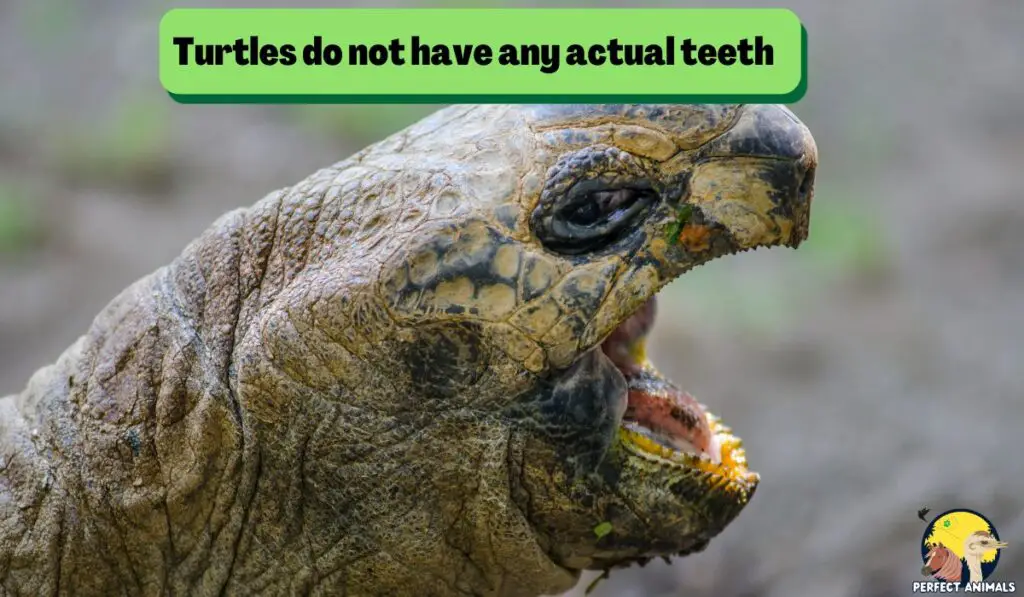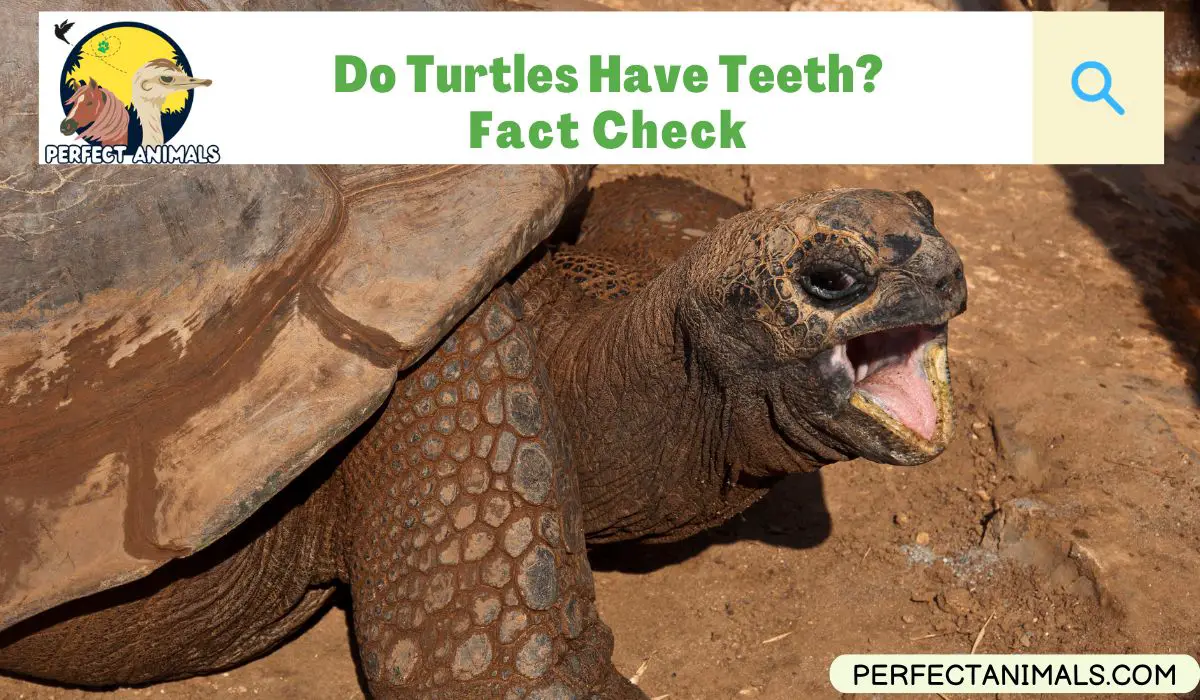As a reptile lover, I’ve always been fascinated by the anatomy of turtles.
Unlike mammals, turtles do not have true teeth.
However, some species have sharp, serrated edges in their mouths that function like teeth.
These structures are called tomia.
Tomia helps turtles bite, grip, and even chew their food.
In this article, we’ll explore the question – do turtles have teeth? I’ll cover turtle teeth anatomy for different species like sea turtles, snapping turtles, and more.
You’ll learn all about the tooth-like tomia that help turtles eat and survive without actual teeth.
Let’s sink our teeth into turtle teeth trivia and satisfy your curiosity about whether turtles have teeth!
Do Turtles Have Teeth?
When you look into a turtle’s mouth, you won’t find a set of teeth like humans or other mammals have.
Turtles do not possess any actual teeth. However, they have adapted specialized structures in their mouths that allow them to bite, tear, and chew food effectively without teeth.

Instead of teeth, turtles have a sharp beak made of keratin, the same material found in human fingernails.
Their powerful beak gives turtles a strong bite to capture prey and rip plants or animals into digestible pieces.
While adult turtles lack teeth, newborn turtle hatchlings emerge from their egg with a singular tooth referred to as an “egg tooth.”
The egg tooth helps baby turtles slice through their leathery eggshell so they can hatch. Within a few days or weeks, the egg tooth falls out as it is no longer needed.
So in summary, turtles do not have true teeth like other species. But they have adapted anatomical structures in their mouths and throats that allow them to bite, tear, and swallow food efficiently. Their beaks and tomia make teeth unnecessary for turtles to eat a variety of prey and plants.
Do Turtles Have Teeth in Their Throats?
As discussed previously, turtles do not have true teeth in their mouths.
But do they have any tooth-like structures farther down in their throats?
Some turtle species have protrusions in their throats called “papillae” that point backward. The papillae are made of soft tissue, not rigid enamel-like in teeth.
These papillae act to help turtles swallow food fully without it getting stuck or floating back up their throats.
The backward-pointing papillae trap prey and transport it from mouth to stomach more efficiently.
So while turtles lack genuine teeth down their throats, adaptations like papillae allow certain species to swallow slippery food and prevent choking.
The papillae are not serrated like the tomia cutting structures on a turtle’s beak. They simply facilitate swallowing rather than biting or chewing.
This improves their ability to get food into their stomachs once caught in their toothless mouths.
Related Article – Turtles Without Shells
Do Sea Turtles Have Teeth?
Sea turtles like green sea turtles, hawksbill turtles, and leatherbacks do not possess actual teeth like land-dwelling mammals.
However, they have adapted specialized mouths to help them eat a marine diet without teeth.
Most species of sea turtles have tomia with serrated edges that function like teeth. Their tomia allow them to bite, grip, and tear aquatic plants like seagrass and algae.
Sea turtles also use their sharp tomia to capture and eat animals like jellyfish.
The tomia-cutting structures are made of keratin, just like a turtle’s beak.
They are saw-like in shape with sharp edges, ideal for slicing through slippery sea vegetation and grasping squishy marine animals.
While leatherback sea turtles lack serrated tomia, they have backward-pointing papillae in their throats.
These papillae prevent jellyfish from floating back out of the turtle’s mouth and help transport food to the stomach.
So while they do not technically have teeth, sea turtles’ unique oral anatomy helps them bite, chew, and swallow food underwater.
Related Article – Do Sea Turtles Drink Water?
Do Snapping Turtles Have Teeth?
The common snapping turtle is a frequently seen turtle species in ponds and wetlands.
While they do not possess true teeth, snapping turtles have sharp tomia that resemble serrated teeth.
Their tomia have multiple sharp edges that face inward. This allows snapping turtles to capture and tear apart a wide variety of prey.
The saw-like tomia of snapping turtles give them an incredibly powerful bite.
They use their tooth-like tomia to snap up animals including insects, fish, frogs, snakes, and even small mammals near the water’s edge.
Snapping turtle tomia also helps rip aquatic plants to complete their omnivorous diet.
Do Hawaiian Green Sea Turtles Have Teeth?
The Hawaiian green sea turtle, also called honu locally, is an iconic sea turtle species found in the waters surrounding Hawaii.
They do not possess any actual teeth in their mouths.
However, Hawaiian green sea turtles have specialized tomia with serrated edges that function like teeth. Their tomia allow them to eat a vegetarian diet primarily consisting of seaweed and algae.
Honu uses their sharp keratin tomia to rip aquatic plants from reefs and rocks near shore. They are able to grasp and shear bite-sized pieces of seaweed and algae to swallow.
Unlike some other sea turtles, Hawaiian greens do not need papillae in their throats to help swallow slippery prey. Their diet means they can fully consume vegetative matter utilizing only their tooth-like tomia.
The tomia’s serrated edges compensate for their lack of real teeth and make Hawaiian green sea turtles efficient herbivores.
You May Also Like – Do Sharks Travel in Packs or Alone?
Do Turtles Have Tongues?
Yes, turtles do have tongues! While their tongues may look different from a human’s, they serve important functions.
A turtle’s tongue is attached to the bottom of its mouth. The tongue is relatively small and triangular or oval-shaped.
It is covered in soft pink tissue and papillae bumps rather than the specialized taste buds found on human tongues.
Turtles use their tongues to move food around in their mouths and properly position it for swallowing.
Their tongues also aid in the swallowing process to transport food from the mouth to the esophagus.
Additionally, turtle tongues assist in breathing.
By manipulating their tongue, turtles can control airflow and pump water over their gills or take in air to breathe.
While turtle tongues are not heavily adapted for tasting potential food sources, they are still an important body part. Turtle tongues help with feeding, swallowing, and respiration.
You May Also Like – Do Fish Blink?
Do Turtles Bite Hard?
Some turtle species can deliver an impressively powerful bite! Snapping turtles in particular are known for biting hard with their tooth-like tomia.
The common snapping turtle has a beak shaped almost like a hawk’s bill, but lined with sharp saw-like edges.
They are able to generate up to 1000 pounds of bite force with their strong jaws.
This allows snapping turtles to tear and cut prey efficiently.
The bite of a large snapping turtle is strong enough to amputate human fingers.
Their incredibly forceful bite makes sense given their diet of tearing apart plants, mollusks, insects, fish, and aquatic mammals.
Other species like soft-shell turtles have much weaker bites.
Their diet consists of slower-moving invertebrates that don’t require an intense crushing force to eat.
So while not all turtles can bite intensely, the powerful jaws and tomia of snapping turtles give them the ability to bite with remarkable force.
Their strength allows them to utilize their tooth-like mouthparts to feed on a wide variety of animals and plants.
You May Also Like – Do Fish Have Blood?
Final Thoughts
Turtles are amazing creatures that have adapted well to life without true teeth.
While they lack the dental anatomy found in mammals, turtles have evolved specialized structures to help them effectively use their toothless beaks.
Serrated tomia allow turtles to grasp and shear food, while papillae in the throat aid in swallowing efficiently.
Different turtle species showcase a variety of unique adaptations for thriving without teeth from vegetarian sea turtles to carnivorous snapping turtles.
It’s fascinating to see how turtles have developed the means to bite, chew, and eat such a diverse diet without the benefit of teeth.
Their versatile beaks and modified mouthparts prove that vertebrates can prosper without standard dentition.
Their specialized beaks and throats allow them to flourish in their niches as efficiently as any toothed animal.
FAQs
Do baby turtles have teeth?
No, baby turtles do not have true teeth. However, they hatch with an egg tooth which is a single temporary tooth used to break out of the egg shell. The egg tooth falls out quickly after hatching.
Do turtles have tongues?
Yes, turtles do have tongues. Their tongues are small, oval-shaped, and attached to the floor of the mouth. Turtle tongues help manipulate food for swallowing and aid in breathing.
How do turtles eat without teeth?
Turtles use their sharp beaks and jaws along with structures called tomia to bite, grip, tear, and chew food effectively without teeth.
Serrated tomia act like teeth to cut plants and prey. Some turtles also have throat spines called papillae to help swallow food.
Resources – (for further reading)
ResearchGate – Turtles with “teeth”: beak morphology of Testudines with a focus on the tomiodonts of Painted Turtles (Chrysemys spp.)
UCSB Science Line – Do turtles have teeth? Do only some types have teeth? If so, do the teeth fall out like ours?
Smithsonian Ocean – Sea Turtles | Smithsonian Ocean

Maya’s love for reptiles started in her teens with a pet snake. It grew into a collection of geckos, snakes, and more. She also cares for birds and cats, making a cozy home menagerie.

